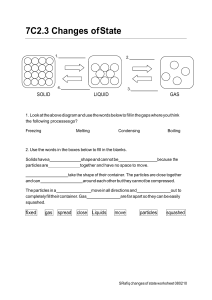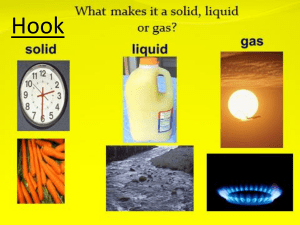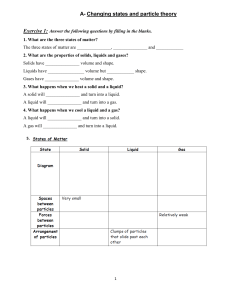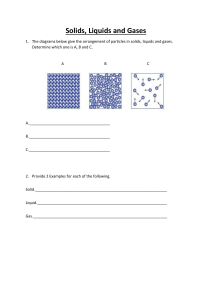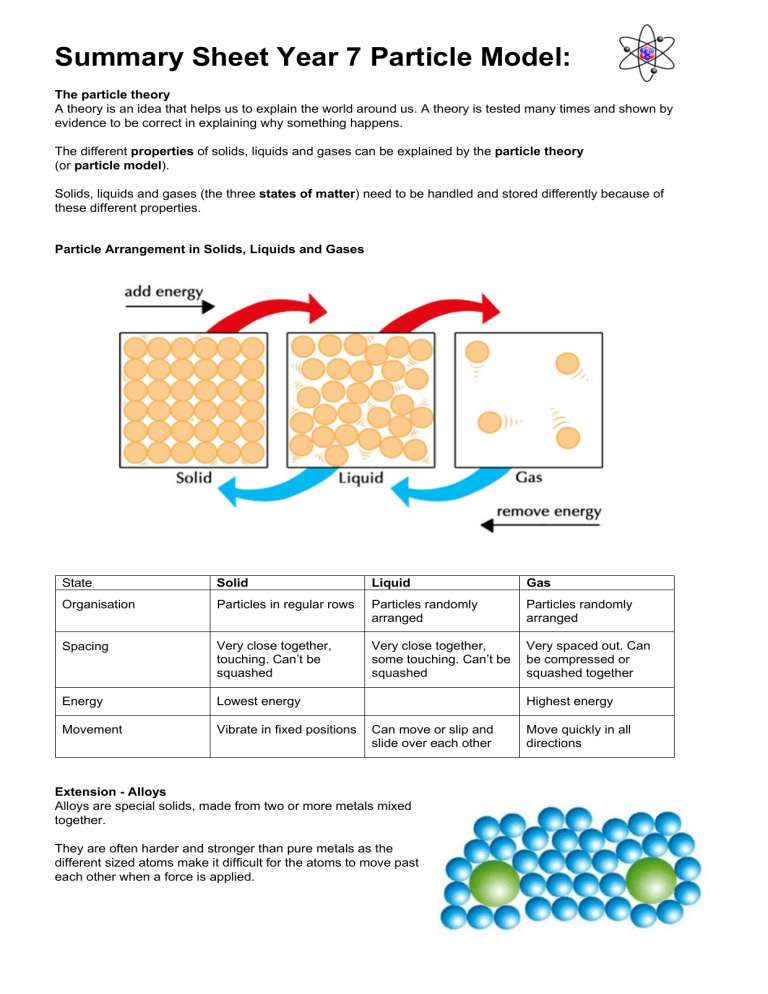
Summary Sheet Year 7 Particle Model: The particle theory A theory is an idea that helps us to explain the world around us. A theory is tested many times and shown by evidence to be correct in explaining why something happens. The different properties of solids, liquids and gases can be explained by the particle theory (or particle model). Solids, liquids and gases (the three states of matter) need to be handled and stored differently because of these different properties. Particle Arrangement in Solids, Liquids and Gases State Solid Liquid Gas Organisation Particles in regular rows Particles randomly arranged Particles randomly arranged Spacing Very close together, touching. Can’t be squashed Very close together, some touching. Can’t be squashed Very spaced out. Can be compressed or squashed together Energy Lowest energy Movement Vibrate in fixed positions Highest energy Can move or slip and slide over each other Extension - Alloys Alloys are special solids, made from two or more metals mixed together. They are often harder and stronger than pure metals as the different sized atoms make it difficult for the atoms to move past each other when a force is applied. Move quickly in all directions Summary Sheet Year 7 Particle Model: Extension - Viscosity Liquids and gases can be poured and will flow, as the particles can move past each other quite easily. Some liquids flow more easily than others. Resistance to flow is called viscosity. A more viscous liquid has stronger forces holding the particles together and will flow less easily. e.g. treacle and syrup are viscous liquids. Changing States Evaporation is a change from liquid to gas, but can occur well below a liquid’s usual boiling temperature. Some substances (carbon dioxide and iodine) can turn directly from a solid into a gas without melting. This is called sublimation. Heating and Cooling Curves The graph opposite shows a heating curve. Ice is heated and the temperature is taken at regular time intervals. Notice that when a substance such as ice is heated, the graph levels off where the substance is changing state. The heat energy is being used to separate the particles and the substance will remain at the same temperature until all of it has changed state. This is called latent heat. Melting and Boiling Points No substance has the same pair of melting and boiling points. Melting and boiling points can be used to identify the state that a substance is in, at any given temperature. Room temperature is normally 25 ºC. Summary Sheet Year 7 Particle Model: Diffusion Diffusion is said to have occurred when chemicals mix together without anything moving them. It is the process by which particles in liquids or gases spread out through random movement from a region where there are many particles to one where there are fewer, or from high to low concentration. Diffusion occurs because particles in a substance are always moving around. Diffusion is fastest in gases (as gas particles have higher energies so move faster), and slower in liquids. Dilution When you add water to orange squash you dilute it. The colour becomes paler because the orange coloured squash particles are spread out more among the water particles. Pressure in gases Pressure is a force caused by particles hitting the walls of the container they are in. The pressure may increase because: ● ● the container has been squashed, making the volume smaller so that the particles will be hitting the walls more often. the number of particles has been increased, so that there are more particles moving around to hit the walls. If the particles are in a flexible container, like a balloon, an increase in pressure inside the container can make the volume increase. If the pressure becomes too great, the balloon will burst. Air pressure is the pressure caused by air particles around us. Air pressure lets us suck things up using a straw and also causes a container to collapse if the air is sucked out. If all the air is sucked out of a container, you get a vacuum – nothingness. Extension - Brownian motion When pollen grains in water are observed through a microscope they are seen to move jerkily in different directions. This is called Brownian motion. It is caused by water particles, which are moving all the time, hitting the pollen grains. The pollen grains are small enough so that when many water particles hit one side of the grain, the grain is moved in that direction. Brownian motion provides evidence to support particle theory. Summary Sheet Year 7 Particle Model: Density Density is the mass per unit volume. It can be measured in several ways. The most accurate way to calculate the density of any solid, liquid or gas is to divide its mass in grams (or kilograms) by its volume (length × width × height) in cubic centimetres, cm3 (or cubic metres, m3). Density can be found using the equation: density = mass volume The unit for density is g/cm3 (or kg/m3). The density of water is approximately 1 g/cm3. If solid objects are placed in water and they sink, they have a density greater than water (1 g/cm3). The reverse is also true. You should remember that 1 ml (millilitre) is the same as 1 cm3. In the example above left, an object has been placed into a measuring cylinder of water, on a balance. The volume has increased from 40 70 ml (increased by 30 ml or 30 cm3) The mass has gone up from 72 105 g (increased by 33 g) The density of the object is 33 g = 1.1 g/cm3 30 cm3 (This answer is to 1 decimal place or 2 significant figures) Alternatively, a eureka can is used. A eureka can is a container large enough to hold the object with a spout positioned near the top. The can is filled to the top with water and the object placed in it. The volume of the object is equal to the volume of the water that is forced through the spout and collected in the measuring cylinder. The object is weighed on a balance beforehand. Eureka cans are named after a scientist called Archimedes who first recorded this idea. They are sometimes also called displacement vessels. Remember that the equation for density can be re-arranged to find volume, and mass. mass = density x volume volume = mass density Densities of solids, liquids and gases For most substances, the change from a solid to a liquid state does not mean a big change in volume. This is because the particles stay approximately the same distance apart. This means that the density of a substance, for example iron, does not change by much when it melts. When a liquid changes into a gas, the spacing between the particles increases significantly. This means that the gas takes up a lot more space than the liquid, so its volume increases dramatically. Its density is a much lower value.

